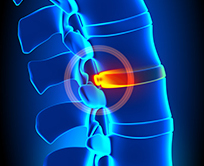Disc Bulge
Description:
Intervertebral discs are composed of a tough, fibrous outer layer called the annulus fibrosus, and a soft, gelatinous inner layer called nucleus pulposus. When the disc is compressed, nearby nerve pain may be caused.
Lower back is where most bulging discs occur, especially at the lower levels, such as L3-4, L4-5 and L5-S1. They can also be seen in the neck and upper back.
Symptoms:
Having a bulging disc can be asymptomatic, meaning some would not experience any symptoms at all. In this case, the disc may be bulging from its normal position, but it is not pressing on any of the exiting spinal nerves or the spinal cord itself. On the other hand, having a bulging disc impinges on a nerve can result in a variety of symptoms, such as:
– In the cervical spine, pain can radiate from the neck, shoulder, down the arm and to the fingers. (Cervical Radiculopathy)
– In the lower back, the damaged disc can cause pain to travel to the hips, buttocks, legs and feet. (Lumbar radiculopathy / Sciatica)
– Numbness
– Tingling
– Weakness
Diagnosis:
Proper diagnosis starts with good medical history and complete physical examination, especially muscle strength, sensation and reflexes. An MRI scan can be ordered, because of its usefulness in showing compression of nerve roots by giving a detailed picture of soft tissue structures. A CT-scan can be used in some cases, such as a patient with a pacemaker. A nerve conduction study / electomyography can also help further test the condition of the nerve-muscle connection, and determine which nerve is affected by the bulged disc.
If surgery for disc pain is considered, some practitioners may recommend a discogram with the goal of confirming which disc is painful. In this test, radiographic dye is injected into the disc, with the belief that a patient is suffering from disc pain (degenerative disc disease) if the injected dye recreates the normal pain.
Causes:
Age is one of the main causes of bulging discs due to degenerative changes and loss of water content of the Intervertebral discs, making them more susceptible to damage. Still, there are other factors that can cause a disc bulge, such as:
- Occupational hazard, repetitive lifting, bending, standing or driving for long distances at a time.
- Improper lifting techniques.
- Obesity, Smoking and excessive alcohol consumption are all contributing factors.
- Severe trauma, such as a car accident.
- A family history of disc disease.
Protect your back when lifting, use good posture, maintain a healthy weight, and exercise regularly to strengthen core muscles supporting body weight.
Treatment:
As previously mentioned, some bulged discs will not require treatment, but for those that do, there are many options.
Physicians will likely start with conservative care; most bulging discs heal with these treatment options within a period of time ranging between 1-6 months, depending on different factors such as age and further aggravation.
- Non-steroidal anti- inflammatory medications (NSAIDS), muscle relaxants, anti-seizure medications and in some instances pain medication.
- Epidural steroid injections to decrease inflammation
- Physical therapy
- Chiropractic traction
- Rest
Surgical treatment is generally not necessary. Once a physician can identify the underlying cause for the bulging disc, it can be treated with an open discectomy if conservative care fails.
